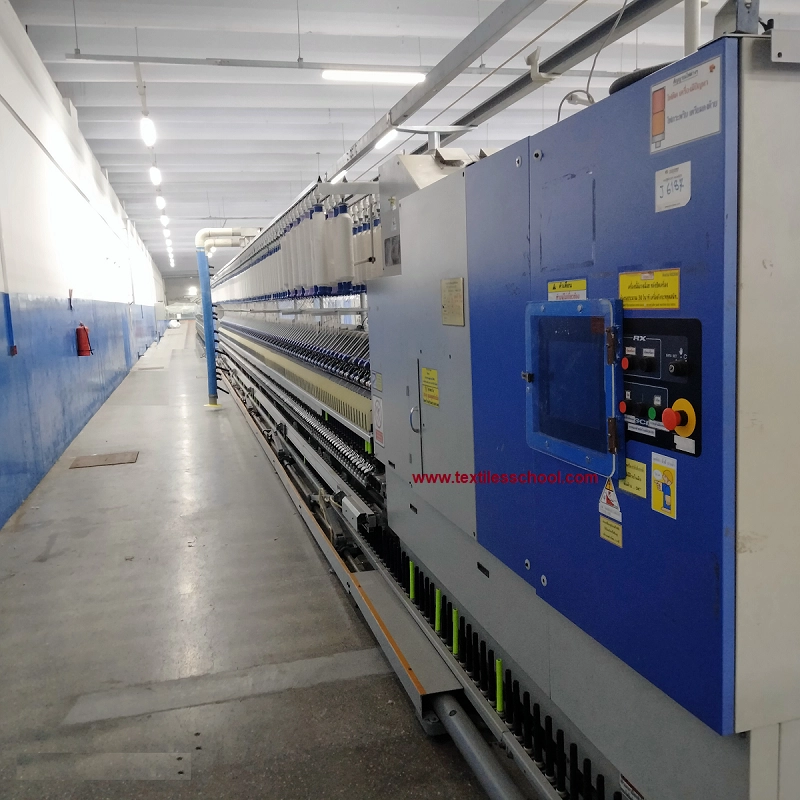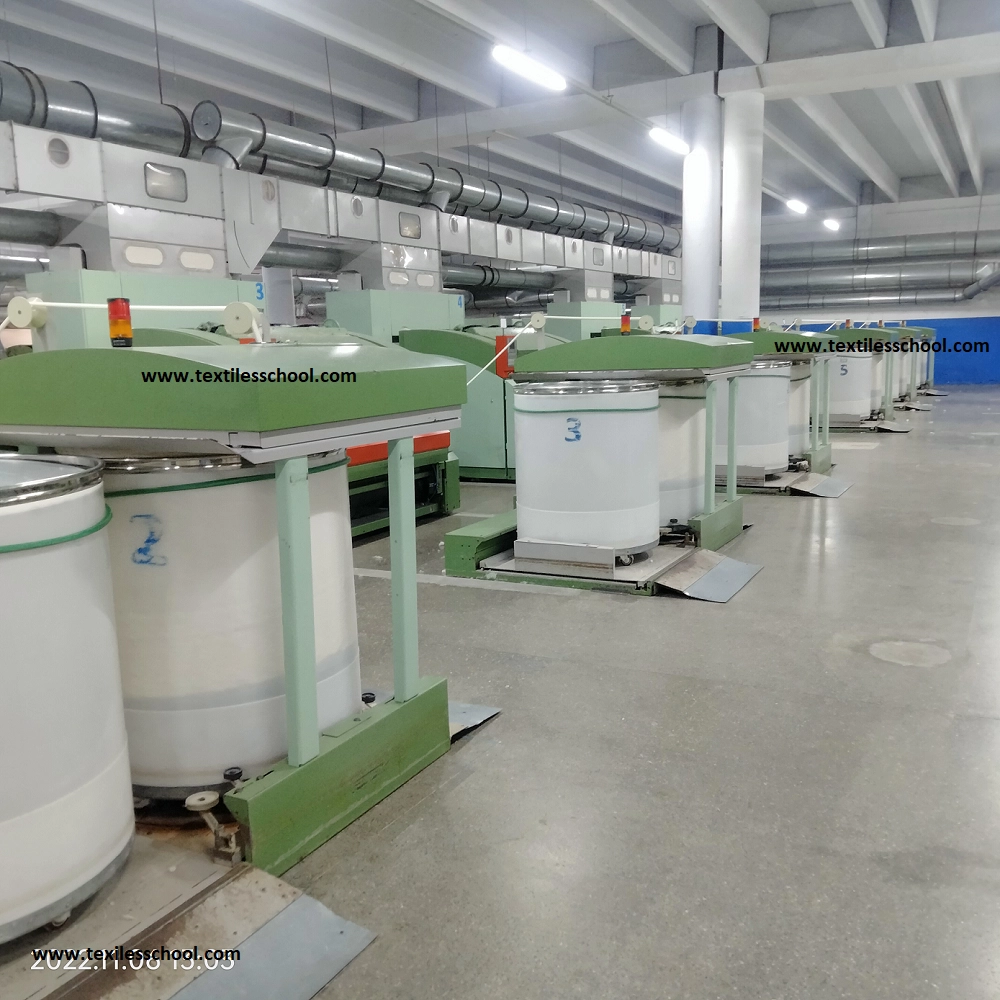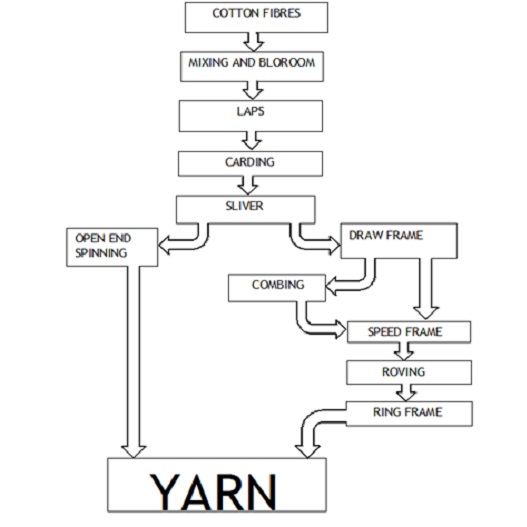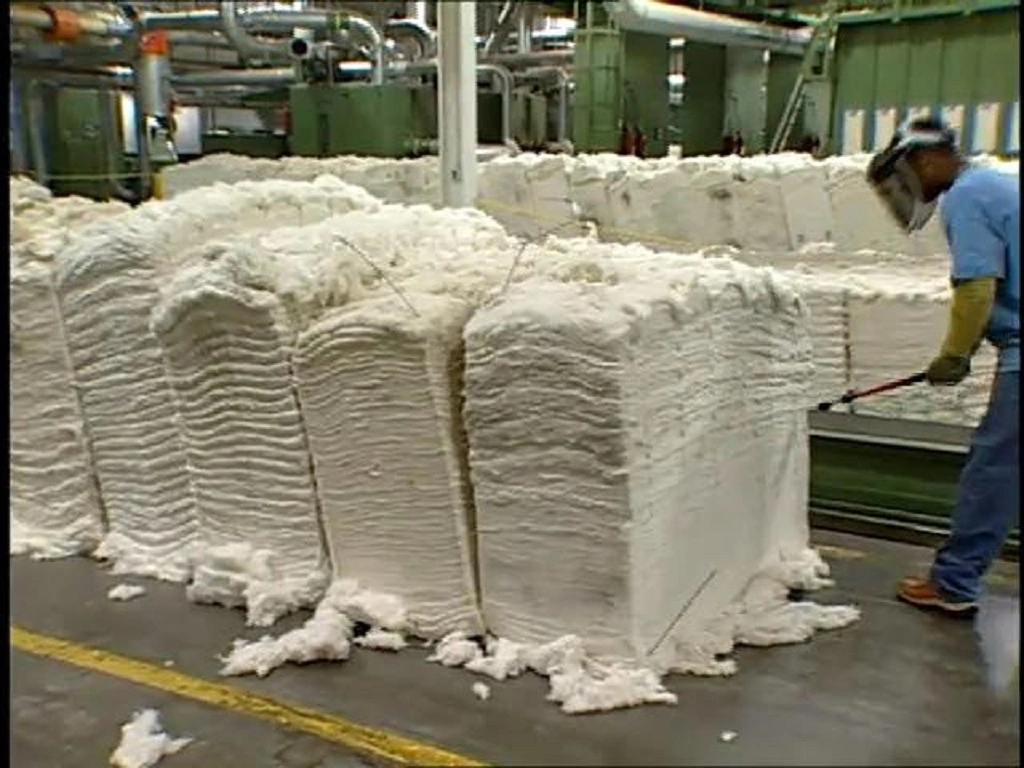Ring frame calculation
Ring spinning has two types: normal or non-compact spinning, and compact spinning also called elite spinning system.
- You may like the content “Textile Fiber Cost Calculation in Blending“
The most important parameter at the spinning ring frame is the output or production of the ring frame, which is termed O.P.S.
O.P.S=(Spindle r.p.m / T.M x sqrt (count)) x 60 x 8 x 16 / 36 / 840 / count x η/ 100
Question a
A)
Calculate the O.P.S of 30/s warp, when the spindle is running at 17000 r.p.m; the T.M in the yarn is 4.1; the production efficiency of the ring is 95%.
Solution
O.P.S=( 17000 x 60 x 8 x 16 x 95)/ (4.1 x sqrt (30) x 36 x 840 x 30 x 100)
= 6.088
B)
What will be the production of the spinning unit consisting of 144000 spindles in bags/day?
Production in bags/day= 6.088 x 3 x 14400 / 16 / 100
=164.4 bags/day
C)
What will be produced at the end of winding if hard waste at the winding frame is 1.5%?
Solution:
Output of winding= 164.4 x 98.5 / 100
=161.93 bags/day.
D)
If the count is changed to 20/s tex what will be the output of the spinning unit assuming T.M 4.0 and hard waste in winding 1.6 %?
O.P.S= 17000 x 60 x 8 x 16 x 95 / (40 x sqrt (29.5) x 840 x 36 x 29.5 x 100)
= 6.4
English count Nec x Tex = 590.5
English count Nec = 590.5/20
=29.5 s
Production of ring department = 14400 x 6.4 x 3 / (16 x 100)
= 172.6 bags/day
Output of spinning unit= 172.6 x 98.4100
= 169.8 bags/day.
Question b
A)
Calculate the O.P.S on the ring frame with the following data
Spindle speed = 17500 r.p.m
Count = 20 s
T.M= 4.2
Production efficiency= 96%
Solution
O.P.S= 17500 x 60 x 8 x 16 x 96 / (4.2 x sqrt 20 x 840 x 36 x 20 x 100)
O.P.S = 11.36
B)
If we want to produce 52/s with the same T.M. what will be O.P.S?
Solution
O.P.S= 17500 x 60 x 8 x 16 x 96 / (4.2 x sqrt (52) x 36 x 840 x 52 x 100)
= 2.71
Safe spinning equation
Important points : (safe spinning)
n = a/H x sqrt(NmT )
where
n = spindle speed
H = Baloon height = frame lift + 1”
Nm = metric count
T = tension in yarn in grams.
i.e
T = fgDn2
where
f = friction b/w ring and traveller
g = traveler weight In grams.
D = ring diameter in inches
i.e
g = H2/(a2NmfD)
Here Nm = metric count
a = constant which can b noted from the given table.
1 ) w.r.t ring diameter
|
Lift in inches
|
Value of ‘a’ | ||
|
Control ring |
Ring diameter in inches |
||
|
1.5” |
2” |
||
| 7 | no | 1.1 | 0.8 |
| 8 | no | 1.4 | 1.1 |
| 9 | no | 1.7 | 1.3 |
| 9 | yes | 1.3 |
1 |
w.r.t count
value of ‘a’
| Lift
in inches |
without control ring
|
With control ring
|
||
| 10/s | 50/s | 10/s | 50/s | |
| 7 | 2.75 | 3 | 3.45 | 3.25 |
| 8 | 2.8 | 3.1 | 3.5 | 3.3 |
| 9 | 2.85 | 3.1 | 3.55 | 3.35 |
Traveler mass i.e minimum traveler weight at for optimum spinning is given by
M = 0.000048 X H2 X N/2R
M = traveler mass in gram
H = balloon height
N = tex count
R = ring radius in inches
Question 5
A ring frame is spinning 60/s cotton yarn. The ring diameter is 1.5″ and the lift is 9″. Spindle is running at 12000 r.p.m, if f = 0.25, find the mass of the traveler. There is one control ring and lea strength is 50 lbs.
Solution
Count= 60 s , H = 9 + 1 = 10″
Metric count Nm = 1.693 x N e
= 1.693 x 60 = 101.58
Value of a = 1.3 ( from the table )
g = H2/(a2 NmfD)
Hence, g = (10)2/((1.3)2 x (101.58)(0.25) x1.5)
g = 1.55 gm
Also,
M = 0.000048 x H2 x N/2R
N = 590.5/60 = 9.84 Tex
M =0.00048 x (10)2 x ( 9.84)/(2 x 1.5/2)
= 0.031 gm
Question 6
A ring-spinning frame produces 60 s with a T.M. of 4.0. The spindle speed of 15000 r.p.m and the ring diameter is 1.5″. Front roller speed is 150 r.p.m. The front roll diameter is 1″ and the production efficiency of 94 %. Calculate traveler linear speed and winding rotations in ft/sec and m/sec.
Solution
Spindle speed -traveler speed = traveler lag(winding rat.)
Also, winding speed = front roll delivery inches/ mm/(πD (package diameter))
= π x 1 x 150 =107.14 r.p.m
15000 -traveler speed =107.14
Traveller speed =14893 r.p.m
Linear speed of traveller =14893 x 1.5 x π/( 60 x 12)
= 97.5 ft/sec
=97.5 x 12/39.37 = 29.7 m/sec.
Question 7
A ring-spinning frame has a 1.5″ diameter of the ring and a linear speed of traveler as 120 ft/sec.
- Calculate the spindle speed ignoring the difference between spindle and traveler speed.
- Also, calculate the limit count to be spun with a T.M. of 3.6 and a delivery rate of 800 inches/min.
- Calculate the required spindle speed to spin 10 s cotton count with 3.6 T.M.
- Also, calculate front roll delivery when the spindle speed is 15000 r.p.m or 40 s cotton count with a T.M of yarn 3.6.
Solution
Traveler speed= 120 ft/sec
Traveller speed = 120 x 12 x 60/(π x 1.5) =18335 rpm
T.P.I = S. speed/front roll delivery
= 18335/800
= 22.92
T.P.I = T.M x sqrt (count)
ct = 22.92/3.6 = 6.34
Count = 40.5 s
Safe spinning question n= /sqrt(HNm)
Or, nH = 1.85 x a x sqrt(count x BL)
BL= breaking load(oz)
or nH = 0.67 x a x sqrt(L.C.S.P)
or
Spindle speed = T.P.I x F.R delivery inches/mm.
= T.M x sqrt(count) x 800
= 3.6 x 10 x 800 = 9107 r.p.m
T.P.I = 3.6 x 40 = 22.768
F.R delivery inches/min = spindle speed/ T.P.I
= 15000/ 22.768
= 658.8 inches/min
Question 8
A ring spinning frame is spinning 50/s cotton count, lift height is 8″ and calculate the minimum spindle speed that is required to spin this count if the yarn has the strength of 60 oz. The ring frame has a large package without control rings.
Solution
As we studied earlier(above)
n H = 1.85 a X sqrt(count x BL)
From the table above a is 3.1
n (8+1)= 1.85 x 3.1 x sqrt (50 x 60)
n= 1.85 x 3.1 x sqrt(300)/9 =11.04 thousand
= 11040 r.p.m
Also, calculate the spindle speed if the frame
Lift is 7″ and C.S.P is 2300.
> nH = 0.67 a x C.S.P
n = 0.67 x 3.1 x 2300
9
= 11071
Question 9
A yarn is to be wound on to ring bobbin with uniform speed. The empty bobbin diameter is I”. After 19 minutes of running the diameter becomes 1.5″. The full bobbin diameter is 2.8″. How long it will take to wound on the full package?
Solution
Volume of empty bobbin= π/4 x 12 x L
=07854 x L inch3
Volume of 1.5” bobbin = π/4 x (1.5)2 x L
= 1.767 x L inch3
The volume of yarn= 1.767 L – 0.7854 L
in package= 0.982 x L inch3
Full volume of package = π/4 x (2.8)2 x L
At 2.8″ diameter= 6.16 x L inch3
Volume of yarn on total Package= 6.16 x L – 0.7854 x L
= 5.372 x linch3
0.982 x L inch3 = 19min
5.372 x L inch3= 19 x 5.372/0.982
= 104 minutes
= 1 hr + 44min
Balancing of ring spinning frame production
Question 1
There is 4 Simplex in a spinning each of 120 ends producing a roving of 0.85 hanks with a T.M of 0.9, running at flyer speed of 900 r.p.m at 87 % production efficiency. Waste % age on the ring-spinning frame is 1 % and on the roving frame is 0.4 %. This simplex is to feed the ring section for accurate balancing. The data of the ring frame is as follows :
- Spindle speed= 17000 r.p.m
- Count= 20 Tex
- T.M= 3.8
- Production η= 94%
Calculate the number of ring frames each consisting of 960 spindles.
Solution
cotton count = 590.5/20 = 29.5s
Simplex production per spindle = 900/0.9 / sqrt(0.85) x 60/36/840/0.85 x 87/100
= 2.20 lbs/hr
Production of simplex section= 2.20 x 120 x 4=1057.3 lbs/hr
O.P.S on ring= 17000 x 60 x 8 x 16 x 94/3.8/sqrt(29.5)/ 36 / 840 / 29.5 / 100
= 6.67
Production of Ring frame= 6.67 x 960/16 / 8
= 50 lbs/hr
Input for ring= 50 x 100/99 = 50.5lbs/hr
No. of ring frames = 1057.3/50.5= 20.94
= 21 frames.
Question 2
There are 30 ring frames each of 480 spindles in a spinning unit producing 40 metrics. The spindle speed is 16500 r.p.m; T.M is 4.0 and the production efficiency of 95%. Calculate the number of roving frames required to feed this section properly. The data for the roving frame is as follows:
- Flyer speed = 900 r.p.m
- Hank roving = 1.1s
- T.M=1. 0
- Prod η= 87%
- Ring waste % age=1.25%
- No. of spindles per machine=120
Solution
Nm= 1.693 x Ne
40= 1.693 x Ne
Ne= 23.6s
O.P.S at ring = 16500 x 60 x 8 x16 x 95/ 4/ sqrt(23.6) / 36 x 840 x 23.6 x 100
Production of Ring department= 8.72 x 840 x 30/16/8= 980.75 lbs/hr
Input for ring= 980.75 x 100/ 98.5
= 995.7 lbs/hr
Prod of Roving per spindle= 900 x 60 x 87/ 1 /sqrt(1.1) / 36 / 840 / 1.1 / 100
= 1.35 lbs/hr
Production roving frame= 1.35 x 120= 161.6 lbs/hr
No. of roving frames = 980.75/161.6 = 6.07
= 6 frames
Question 3
Calculate the number of simple frames to feed to a ring department, producing 25000 lbs/day. Hank roving required is 0.96 and 1.15 T.M. Flyer speed is 1000 r.p.m and the number of flyers per m/c is 120. Waste % age in the ring is 1.2% and η of the roving department is 85%.
Solution
Production of simplex per end= 1000 * 60 *85/1.15 / sqrt()0.96 / 36 / 840 / 0.96 / 100
= 1.56 lbs/hr
Production of frame= 1.56 x 120 = 187 lbs/day
Input for ring= 25000 x 100/98
= 25303.6 lbs/day
Or prod of simplex = 187/1 x 24 = 4490.3 lbs/day
No of m/c= 25303.6/4490.3= 5.64 frames
So no. of simplex= 6
124
Average count
When a mill is spinning more than one count, it is necessary to calculate the average count produced by the mill for tax and other payments. The average count can be calculated from the formula.
Avg count= total no. of hanks in the mill from all counts total yarn in ponds from the whole mill.
Question i
What will be an average count of 10s and 20s assuming the same spindle speed, same T.M., and same no of spindles?
Solution I
count= No. of Hanks/Ib.
Let one hank of each count
For 10s No. of lbs= 1/10= 0.1 lbs
For 20 s number of lbs =1/20 = 0.05 lbs
Total weight= 0.1 + 0.05 = 0.15 lbs
Total hank= 2
Avg count= total hanks= 2/0.15
Avg. count = 13.33 s
Question ii
Calculate avg. count of 80/S, 50/S, 40/S, and 20/S, assuming the same speeds, same spindles, and same T.M.
Solution ii
For 80/S weight= 1/80= 0.0125 lbs
Also, for 50/S weight = 1/50 = 0.02 lbs
For 20/S weight= 1/20= 0.05 lbs
Also, for 40/S weight = 1/40= 0.025 lbs
Average count = (3+1)0.0125/0.02/0.05/0.025= 4/0.1075
Hence, average count = 37.2 S
Question iii
Calculated avg. count of counts 20s, 30s and 38s. when the number of bags for each count is 70, 5,0, and 30 bags per day, respectively.
Solution iii
When production is given we can find out
Average count by formula
Avg count = (C1Q1 + C2Q2 + C3Q3)/( Q1 + Q2 + Q3)
Where C = count
Q = production
Avg count =20 x 70+30 x 50+38 x 30/(70+50+30)
=26.93/s
Question iv
Find the average count of 5 different counts prepared in a ring spinning unit, assuming the same spindle speed with the same T.M. Data for different counts is as follows
10s count at 4 frames. Each of the 480 spindles
20s count at 10 frames 450 spindles
40s count at 20 frames 400 spindles
50s count at 10 frames 500 spindles
60s count at 20 frames 480 spindles
Solution iv
In this case, we can find out the average count by using a relation.
Average count = spindles x count + Spindles x count + …../(Spindles + Spindles + ….)
Average count = 10 x 4 x 480+20 x 10 x 450+40 x 20 x 400+50 x 10 x 500+60 x 20 x 480/ (4 x 480+10 x 450+20 x 400+10 x 500+20 x 480)
= 43.25/s
Question v
Calculate the avg. count for the following data
20/s on 10 frames.
30s on 10 frames
40s on 5 frames
50s on 5 frames
There are 480 spindles on each frame.
Solution v
Average count= 20 x 10+30 x 10+40 x 5+50 x 5(10+10+5+5)
= 950/30 = 31.67/s
Question vi
Calculate the avg count of 30s and 15/s when both are used to make warp count 20 frames each.
Solution vi
For 15s weight = 1/15= 0.067
For 30/s weight =1/30 = 0.033 lbs
Total weight= 0.067 + 0.033= 0.1 lbs
Avg count= 2/0.1=20 s
Question vii
(a)Calculate the avg count of 40s and 20s yarn both giving 500 bags/day.
Solution vii
Avg count = 40 x 500+20 x 500(500+500)
=30/s
(b)
When there are 16000 spindles for 60/s and 12000 ends for 40/s, calculate the average count
Solution
Avg count= 60 x 16000+40 x 12000(16000+12000)
= 51.43/s
(c)
Calculate average count of 40s , 36s , 38s , 30s and 24s hosiery yarn.
Solution
For 40s wt = 1/40= 0.025 lbs
So, for 36s weight =1/36 = 0.028 lbs
For 38/s weight =1/38= 0.026 lbs
Also, for 30s weight =1/30= 0.033 lbs
For 24s wt = 1/24 = 0.042 lbs
Average count =5*/0.154= 30.47s



